Influencer marketing has grown really strong as social media has become a bigger part of our daily lives. People now turn to their favorite stars on Instagram, Twitter, and YouTube for advice on what to buy.
Social media has even allowed ordinary people to build their own brands by sharing engaging content with their audience.
But to make the most of any influencer you work with, creating a solid influencer marketing plan is important.
Today, we’ll highlight some important influencer marketing stats that can help shape your strategy for 2025 and beyond.
We’ll cover everything from how much brands spend on influencers to their preferred payment methods.
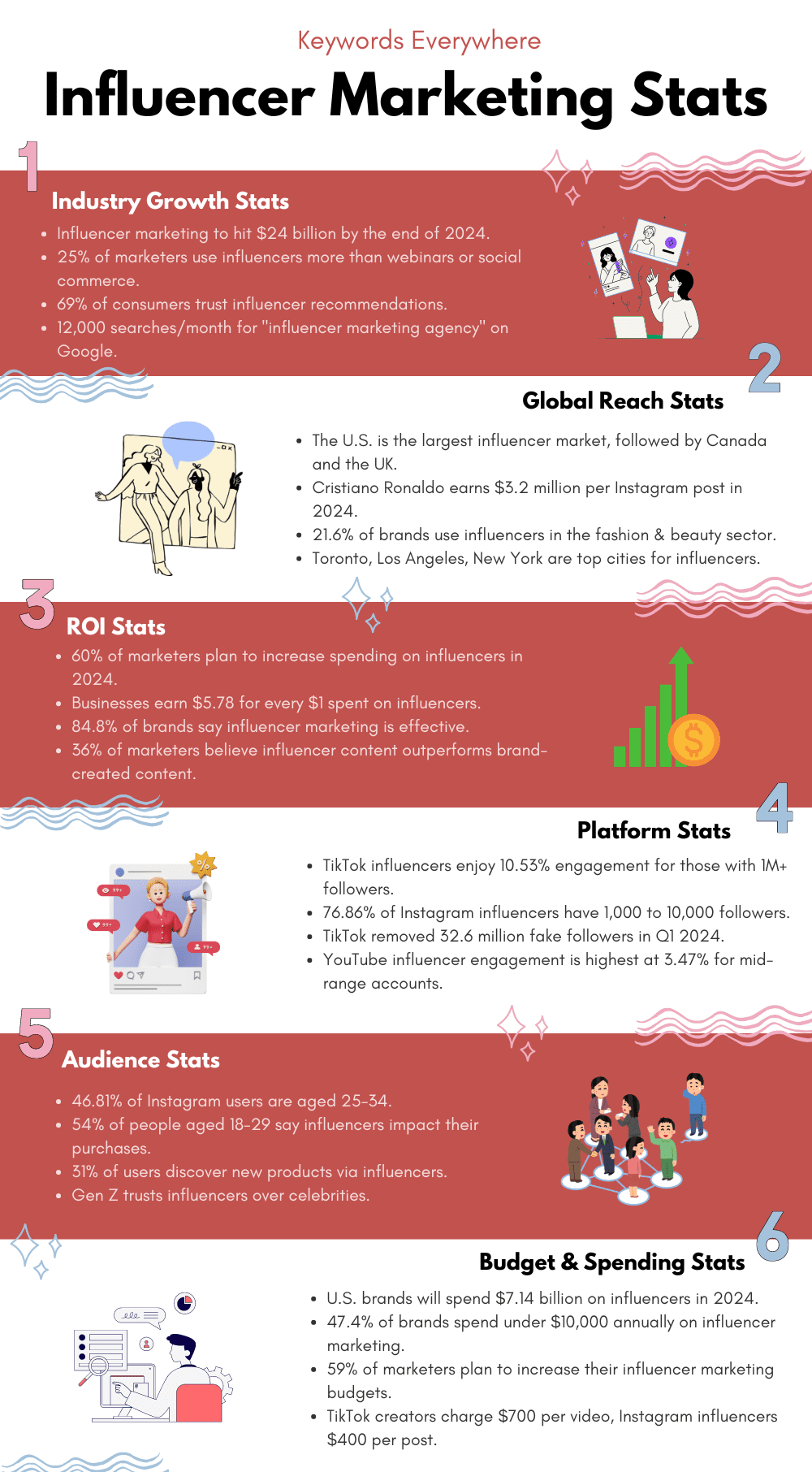
What is Influencer Marketing?
With influencer marketing, brands team up with online influencers to promote their products or services.
While a recommendation from a friend or family is helpful, it’s just a one-on-one conversation. Influencers, on the other hand, can reach hundreds, thousands, or even millions of people at once.
They also work hard to build trust with their audience, which makes their recommendations more convincing than other types of ads.
Because of all these reasons, influencer marketing is now one of the fastest-growing marketing strategies.
So, if you want to connect with new audiences online, partnering with influencers can be a powerful way to do it.
General Influencer Marketing Stats
Now that you understand what influencer marketing is, let’s take a look at some key stats about it. These will help you see the real benefits that this type of marketing offers:
1. The influencer marketing industry is expected to reach $24 billion by the end of 2024, showing strong growth even in tough economic times.

Source
2. 25% of marketers now work with influencers to promote their products and services, making this approach more popular than virtual events, webinars, and social commerce.
3. 69% of consumers trust the recommendations that influencers make about new products or services.
4. In a global survey of marketers conducted in January 2023, 28% said that keeping up with social media trends is a top challenge in influencer marketing. Following closely, 26% mentioned the cost of working with influencers as another major challenge.
5. According to Keywords Everywhere, nearly 12,000 people search for “influencer marketing agency” on Google every month, showing that brands are eager to find influencers to help market their products.
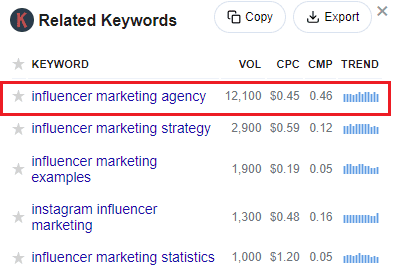
6. Marketers often prefer working with smaller influencers. The HubSpot 2024 Social Media Marketing Report found that 64% of marketers have teamed up with micro-influencers, and 47% said they had the most success with them.
7. Creating relevant content is the main goal for marketers. 44% of influencers enjoy collaborating with brands to create content that resonates with their followers.
8. According to the Collabstr 2023 Influencer Marketing Report, 77% of content creators who earn money from their work are women, while 23% are men.
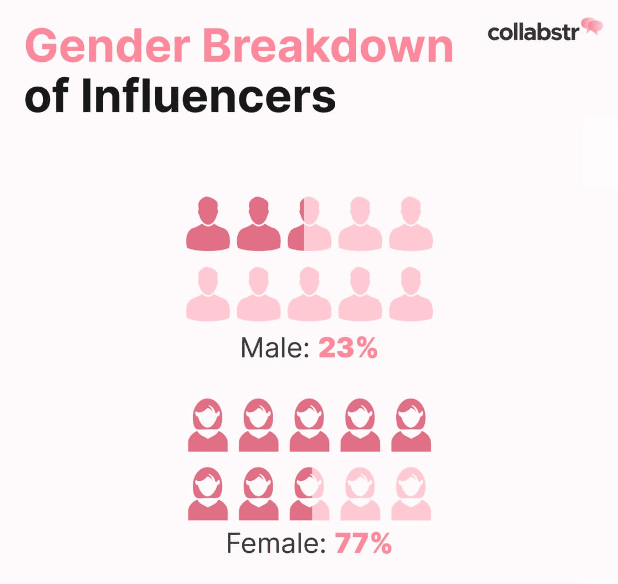
Source
Influencer Marketing Global Stats
Which country leads in influencer marketing? What are the top cities? And who makes the most money from it?
Here are some global influencer marketing stats that answer these questions and more:
9. The U.S. is the largest consumer market in the world, so it’s no surprise that it’s the top country for influencer marketing, especially on social media.
10. Canada ranks second. While its market isn’t as big as the U.S., its close proximity means Canadian influencers often have a similar audience to those in the U.S.
11. The United Kingdom is the third most popular country for influencer marketing. It’s also home to some influencer marketing pioneers, like Gymshark.
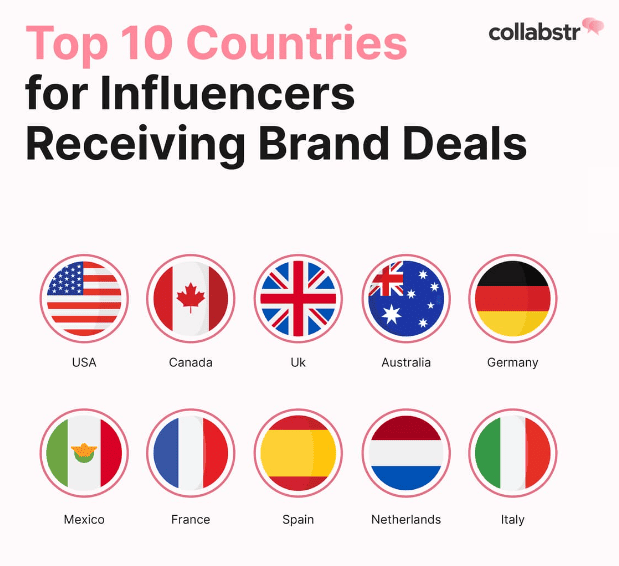
Source
12. In North America, Los Angeles and New York City are still the top two cities for influencers. Toronto, Canada’s largest city, comes in third.
13. Cristiano Ronaldo is the highest-paid Instagram influencer in 2024, earning an estimated $3.2 million for each branded post. Soccer star Lionel Messi follows closely, making $2.6 million per post.
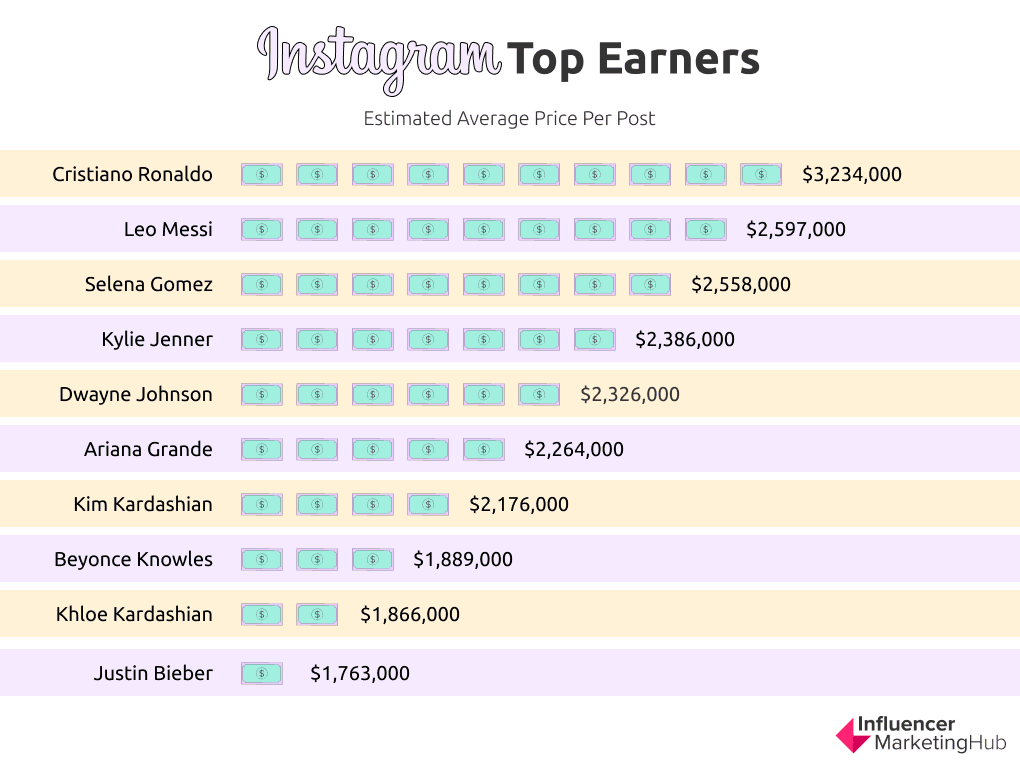
Source
14. Fashion & Beauty is the most popular industry for influencer marketing, with 21.6% of brands using it as a key part of their strategy. Gaming is catching up, with 11.9% of brands increasing their influencer marketing in that area.
15. The most mentioned fashion brands by influencers globally include Zara, Shein, H&M, NA-KD, PrettyLittleThing, and ASOS.
Influencer Marketing Growth Stats
Influencer marketing isn’t a new concept, but it has grown significantly in recent years. These influencer marketing stats show just how popular it has become:
16. Influencer marketing has been growing rapidly in last few years. What started as a $1.7 billion industry in 2016 has ballooned to $21.1 billion in 2023.
17. In the U.S., spending on sponsored content is expected to reach $8.14 billion in 2024, a 58.98% increase since 2021.
18. Nearly 83% of U.S. marketers plan to use influencers for their campaigns this year, an increase of about 4 percentage points from 2023.
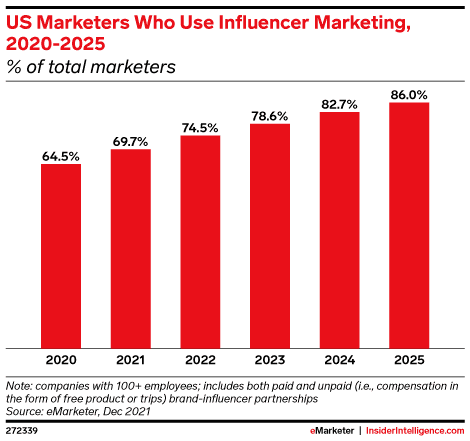
Source
19. Ad spending in influencer marketing is projected to hit $35.09 billion by 2024, showing a 13.9% increase. This means brands are spending more on influencer ads, with an average of $6.16 spent on influencer advertising for each internet user in 2024.
20. In a recent survey, 59.4% of marketers said they plan to increase their budgets for influencer marketing in 2024. Only 9.3% intend to cut back on their spending, slightly higher than the 7% who planned to decrease their budgets in 2023.
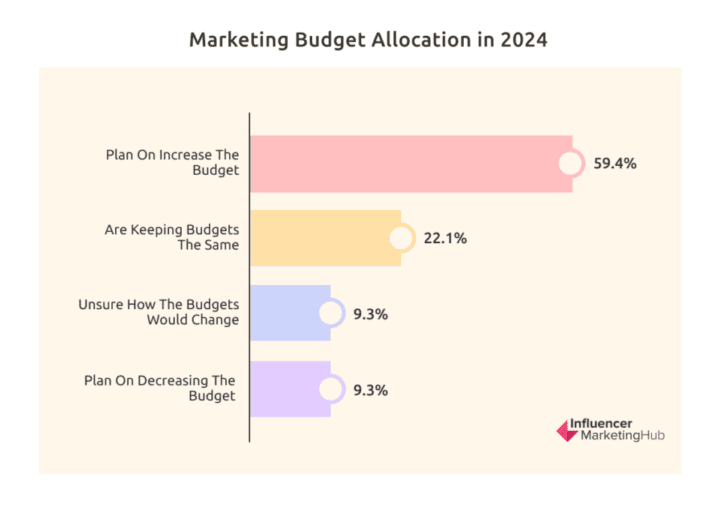
Source
Influencer Marketing ROI Stats
Getting a return on investment (ROI) is key for any marketing strategy. Check out these influencer marketing stats that highlight the ROI others have achieved with their influencer campaigns to show just how effective it can be:
21. 60% of marketers plan to boost their spending on influencer marketing in 2024. On average, businesses earn $5.78 for every $1 spent, with some seeing returns as high as $18—now that’s a great ROI!
22. According to the State of Influencer Marketing report, 84.8% of brands found influencer marketing to be effective in 2024, a slight increase from 83% in 2023.
23. 83.8% of marketers said in the above report that influencer marketing brought in higher-quality customers compared to other forms of marketing.
24. A study by Linqia revealed that 36% of respondents believe influencer content outperforms brand-created content. This better performance could show up in areas like reach, engagement, and conversions.
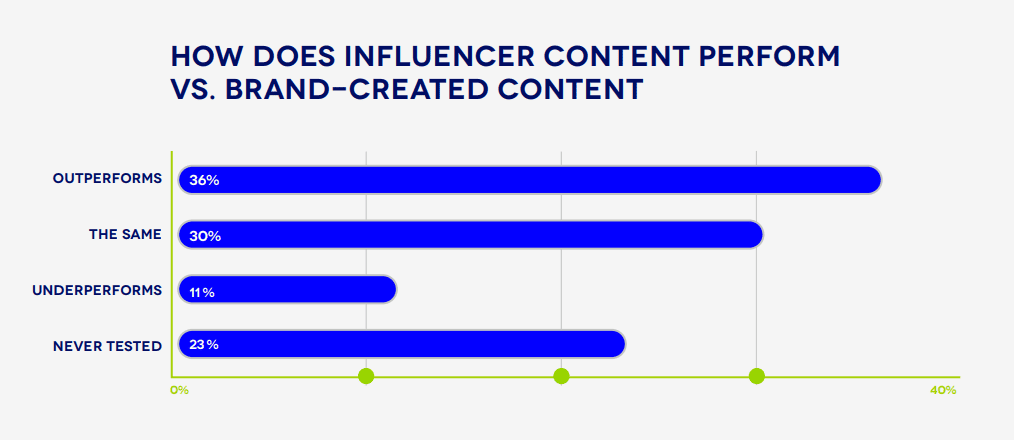
Source
25. Despite more brands seeing the benefits, some still don’t track their success. While 70% of brands measure their influencer marketing ROI, 30% haven’t started tracking it yet.
26. 51% of marketers state influencer marketing helps them attract better customers, likely because the right influencer connects them with an audience full of potential buyers.
27. A Convince and Convert study found that influencer marketing delivers 11 times the ROI of banner ads, which is impressive.
28. About 39% of social media users say influencers have an impact on their buying decisions, though only 3% say they have a significant influence.
29. Younger audiences are more influenced by social media stars: 54% of people aged 18 to 29 say influencers affect what they buy, compared to 42% of those aged 30 to 49 and just 29% of people over 50.
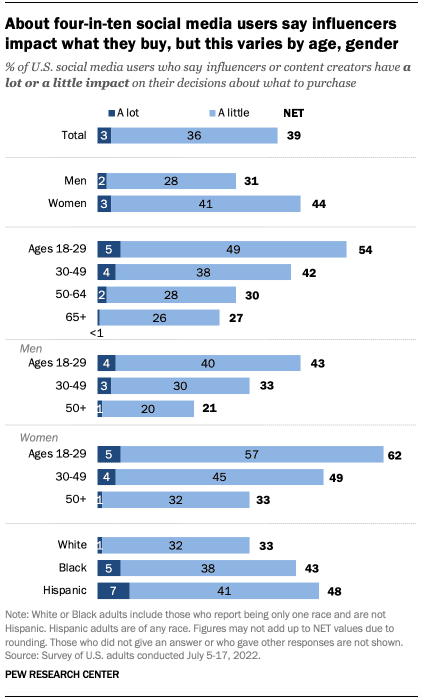
Source
30. 30% of B2B marketers say influencer marketing helps them achieve their top-of-funnel goals more than paid search (28%) or virtual events (23%).
31. Instagram nano-influencers (with fewer than 10,000 followers) have an impressive engagement rate of 6.23%, compared to just 0.70% for TikTok influencers in the same follower range.
Influencer Marketing Audience Stats
When looking for influencers to promote your brand, it’s important to choose those who have followers that match your target audience.
The social media platform where each influencer is most popular also matters—ideally, you want to partner with influencers on the platforms where your potential customers hang out.
Keep in mind that just because you use a certain social network doesn’t mean your customers do, especially if they’re from a different age group or background.
Here are some key influencer marketing stats about the types of people most likely to use social media:
32. Most Instagram users are aged 25-34 (46.81%), followed by those aged 18-24 (33.17%). In both age groups, more females use Instagram than males, though the difference is smaller among 25-34-year-olds: for 18-24-year-olds, it’s 56% female and 44% male, while for 25-34-year-olds, it’s 52% female and 48% male.
33. If you want to reach young females aged 13-24, TikTok is the place to be! About 24.27% of TikTok’s audience are females aged 18-24, and 17.04% are aged 13-17. Interestingly, more males aged 25-34 are on TikTok than younger males, with 15.74% compared to 11.77%.

Source
34. Similar to Instagram and TikTok, more young females watch YouTube than males: 26% of females aged 13-24 watch YouTube, while 22% of males in the same age group do. However, in older age groups, males are more likely to watch YouTube videos.
35. Gen Z generally trusts influencers more than celebrities. In fact, 45% of European Gen Zers are more likely to buy fashion items seen by influencers rather than by traditional celebrities or their friends.
36. Around 33% of Gen Z in the U.S. have bought a product from a brand started by an influencer in the past year, while 29% of millennials have done the same.
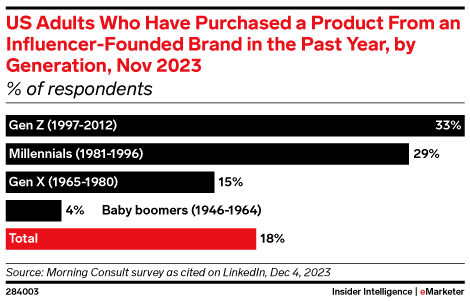
Source
37. According to a HubSpot survey, 31% of social media users prefer discovering new products through influencers they follow, especially Gen Z consumers, where the number rises to 43%.
38. Among social media users aged 18-54, about 21% have made a purchase based on influencer’s recommendation. For Gen Z users, this jumps to 32%.
39. A study by Matters Communications found that educational content is the most liked among influencers. About 42% prefer how-to guides and tutorials, while 35% enjoy stories with bite-sized information.
40. Cooking recipes are the most popular type of influencer content, according to 51% of global social media users, followed by lifestyle content (42%), tutorials (42%), and product reviews (41%).

Source
Influencer Marketing Instagram Stats
Instagram influencer marketing is a key strategy for many brands, and most marketers believe it’s the best platform for influencer marketing.
Check out these influencer marketing stats to learn more about the current state of influencers:
41. TikTok has taken the lead, making Instagram the second most popular platform for influencer marketing. Currently, only 46.7% of brands are using Instagram for this purpose.
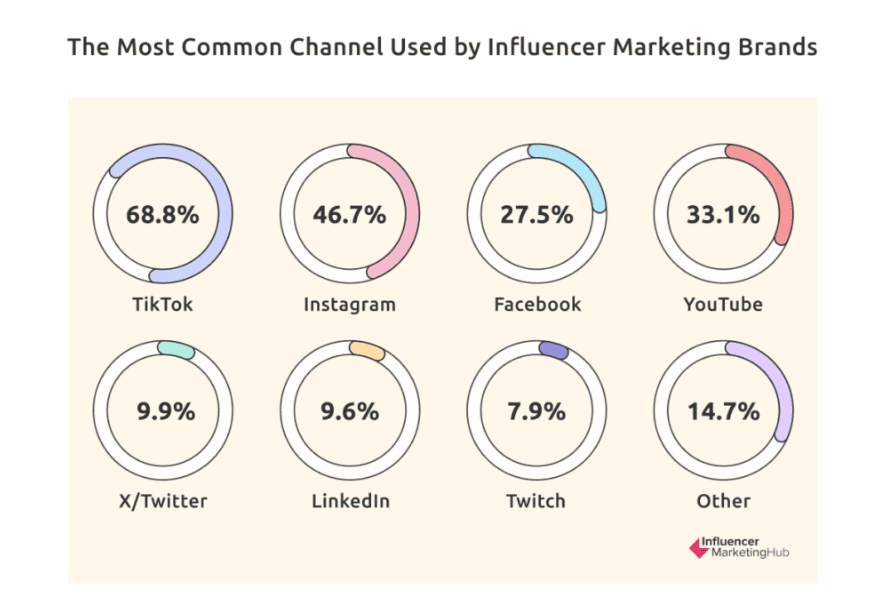
Source
42. With over 500,000 active influencers on Instagram, it’s no surprise that it remains the top platform for influencer marketing.
43. In 2023, 76.86% of influencer accounts on Instagram had between 1,000 and 10,000 followers. The next largest group was micro-influencers, who had 10,000 to 50,000 followers, making up 18.23% of all influencers.
44. The average cost per post for mega-influencers (those with over one million followers) was $1,210 in 2023. For macro-influencers (with 500,000 to one million followers), the average minimum price was $370, with a maximum of $5,000.
45. Instagram posts remain the most popular content type that influencers are paid to create, with 84.2% of respondents choosing this format. Other popular formats include Instagram Reels (63.8%), TikTok videos (27.4%), and Facebook posts (26.8%).

Source
46. According to HubSpot’s survey, 72% of marketers said they work with influencers and creators on Instagram. Most of them (30%) also mentioned that Instagram gives them the best return on investment (ROI) for their influencer partnerships.
47. Fashion brands often use Instagram to promote their clothing, with 25% of all sponsored posts on the platform related to fashion, making it the most popular topic for brand partnerships.
Influencer Marketing TikTok Stats
TikTok and its short videos are a popular choice for influencer marketing. Check out these influencer marketing stats to learn more about TikTok influencers and why this platform is so effective:
48. TikTok influencers enjoy the highest engagement rates. Even those with over 1 million followers have an average engagement rate of 10.53%. Smaller accounts with 1,000 to 5,000 followers see even higher engagement, averaging 15.04%.
49. Accounts with 1,000 to 10,000 followers make up 66.96% of all influencers on TikTok. Micro-influencers, who have 10,000 to 50,000 followers, represent the second largest group at 23.06%.
50. In the first quarter of 2024, TikTok removed about 32.6 million fake followers due to fake accounts. The platform also got rid of over 236 million fake likes during the same period.
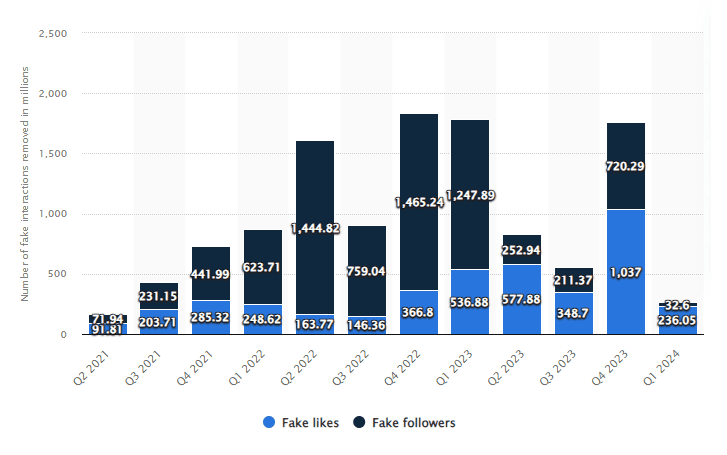
Source
51. As of November 2023, TikTok was the top platform in the U.S. for beauty influencers, with over 1.5 million followers in that category.
52. According to the Influencer Marketing Benchmark Report, more than half of those who experienced discrimination reported it happening on TikTok (58.42%). In comparison, YouTube had 13.62%, Instagram had 12.9%, and Facebook had 10.04%.
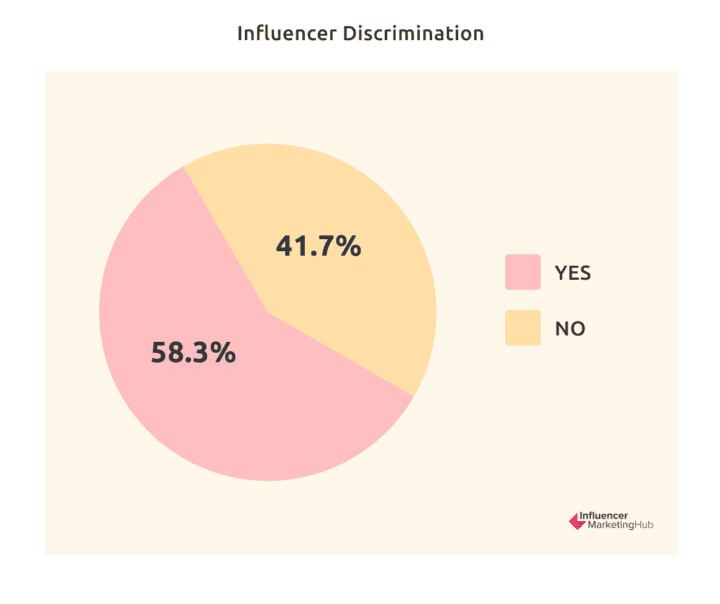
Source
Influencer Marketing YouTube Stats
Now, let’s take a look at YouTube influencer marketing stats and explore the current state of this long-form video platform and its connection with influencers.
53. Facebook has long been one of the top three channels for influencer marketing, but YouTube is now catching up. With 33.1% of brands using it for influencer marketing, YouTube is now the third most popular platform.
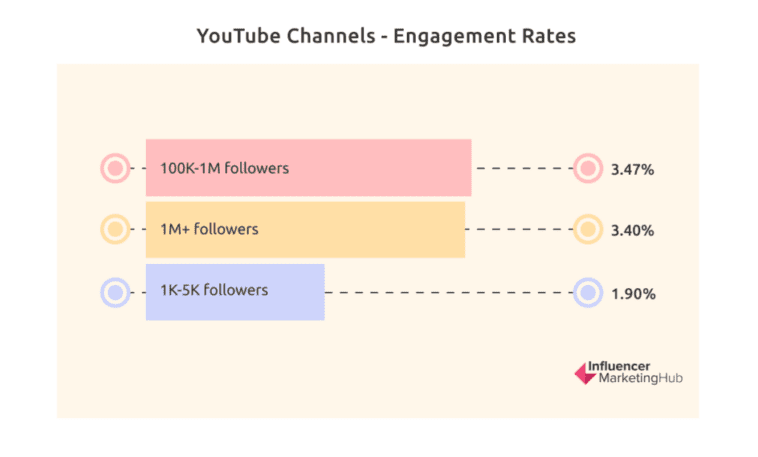
Source
54. YouTube is unique because larger influencers tend to get more engagement. According to the State of Influencer Marketing report, accounts with 1,000 to 5,000 subscribers have an average engagement rate of 1.9%, while those with over a million followers see a rate of 3.4%.
55. The highest engagement rates are found in accounts with 500,000 to 1 million followers, averaging 3.47%.
56. In the U.S., nearly 307,000 YouTube influencers have between 10,000 and 50,000 followers. There are also about 70,000 nano-influencers with 5,000 to 10,000 followers, making them the second most common group.
57. According to Statista, vlogging is the most popular content type, with 28.5% of influencers creating posts about people and blogs. Entertainment comes next, with 14.54% of influencers sharing this kind of content, while video games are also popular, attracting 12.95% of influencers.
58. Given the popularity of gaming, it’s no surprise that Steam is the most mentioned brand on YouTube, with over 76,000 mentions reported by Statista.
Influencer Marketing For Business Stats
Partnering with an influencer can help your business grow faster by creating a lot of buzz. Before you get started, check out these key influencer marketing stats:
59. On average, businesses get $6.50 for every $1 they spend on influencer marketing. In fact, 70% earn at least $2 or more, and 13% see returns of $20 or higher. Only 18% of businesses don’t see any returns, meaning most benefit from influencer marketing.
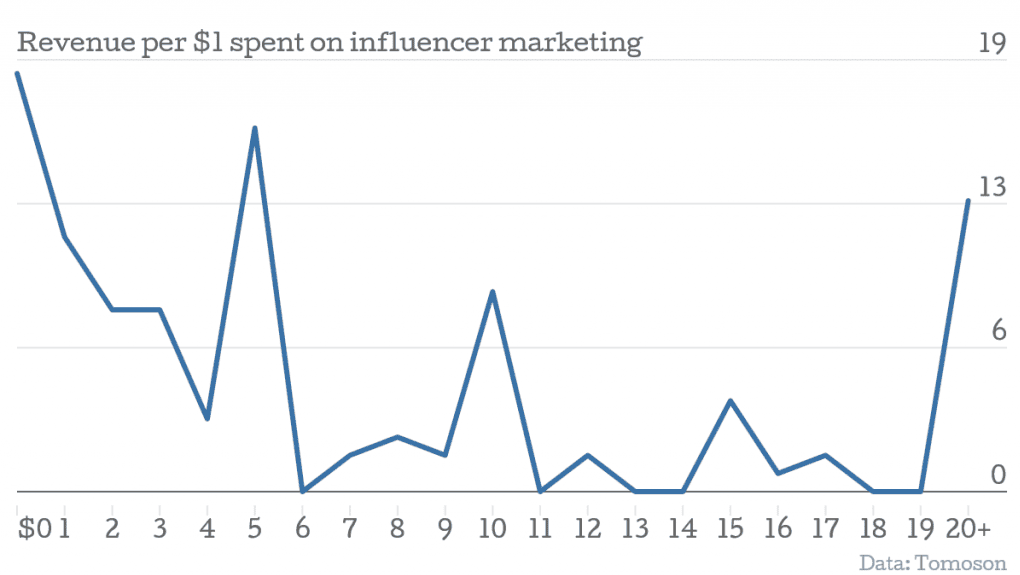
Source
60. For eCommerce businesses, influencers are a popular way to reach new customers. Over half (57.6%) of brands working with influencers run an online store.
61. When choosing an influencer, don’t just focus on big followings. Nano-influencers, who have 1,000 to 5,000 followers, actually have a higher engagement rate (2.19%) than mega-influencers with over a million followers.
62. In a 2023 survey, 58% of U.S. shoppers said they bought something they saw on social media. In the UK, 44% made a purchase, while 40% of shoppers in Germany did the same.
63. Nearly a quarter (22%) of marketers say influencer marketing is the most cost-effective way to get new customers. Email ties at 22%, while organic search ranks third at 19%.
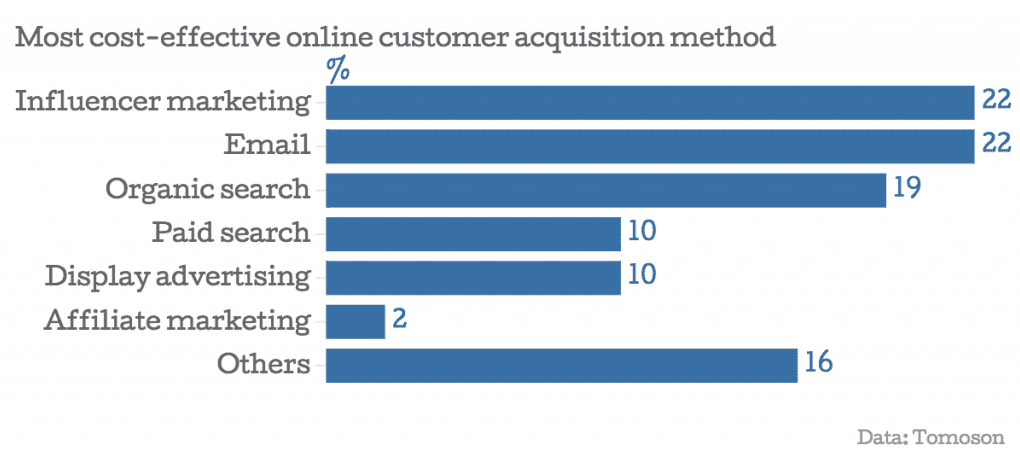
Source
64. TikTok is a powerful platform for sales, with 78% of users saying they bought a product after seeing it in a creator’s content.
65. More than half of women (53%) have bought something after seeing it in an influencer’s post. This trend has pushed more brands to combine eCommerce with influencer marketing.
66. In 2022, 35% of U.S. consumers made a purchase based on a virtual influencer’s recommendation, showing that AI-created influencers are slowly making their mark in marketing.
67. Most marketers (56%) say sales are the most important measure of success in influencer marketing, with clicks and social shares still valued by some but less prioritized than sales.

Source
Influencer Marketing Advertising Stats
Social media ads play a huge role in influencer marketing too. Boosting your influencer content through ads can help you reach even more people.
Let’s dive into some key stats about advertising in influencer marketing.
68. Global spending on influencer advertising is expected to hit $35.09 billion by 2024. From 2024 to 2029, the market is predicted to grow by nearly 10% yearly, reaching a whopping $56.28 billion by 2029.
69. China is set to lead the way in ad spending, with an estimated $19.16 billion in 2024 alone.
70. In 2023, U.S. spending on influencer marketing grew over three times faster than traditional social ad spending and is expected to keep outpacing it through 2025.
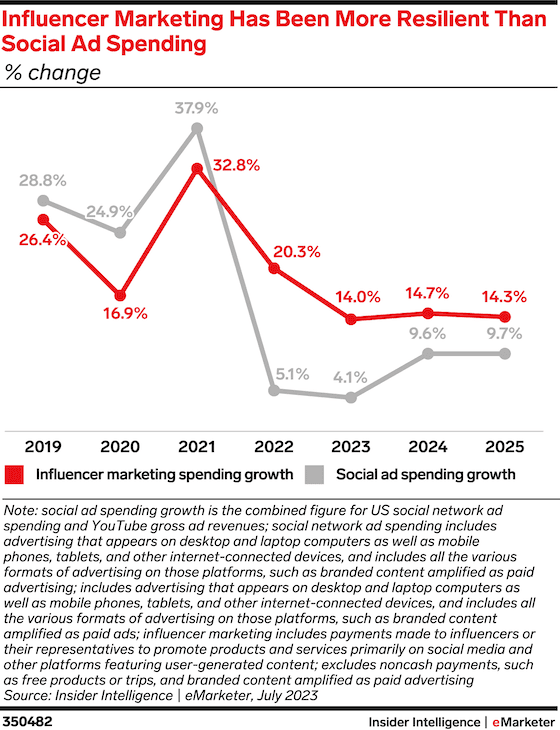
Source
71. In the U.S., influencer advertising is becoming more popular as more brands partner with social media stars to connect with their target audiences.
72. By 2024, the average amount spent on influencer ads per internet user will be around $6.16.
Influencer Marketing Budget Stats
How much are brands investing in influencer marketing? As the industry grows, more of marketing and social media budgets are being directed toward influencers.
Take a look at these key influencer marketing stats to answer all your budget-related questions:
73. In the U.S., spending on influencer marketing is forecasted to reach $7.14 billion in 2024, marking a 15.9% increase from the previous year.
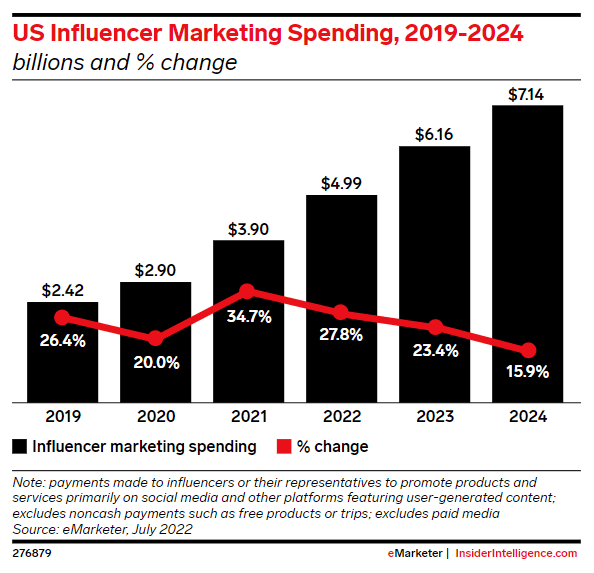
Source
74. A recent survey of marketing agencies and brands found that 22.4% of respondents are putting 10 to 20% of their total marketing budget into influencer marketing. Additionally, 26% are spending more than 40% on this type of digital marketing.
75. When it comes to payments for influencers, those with 100,000 to 150,000 followers typically charge about $400 for a sponsored Instagram post and around $1,500 for an Instagram Reel.
76. TikTok creators usually charge about $700 per video, with rates varying between $250 and $1,700.
77. 59% of marketers plan to boost their influencer marketing budgets next year, showing that this trend is growing and changing marketing strategies across industries.
78. In 2017, only 37% of respondents planned to allocate a budget for influencer marketing. Now, that number has jumped to an impressive 85.8%.
79. In The State of Influencer Marketing Benchmark Report, 47.4% of brands noted spending less than $10,000 annually on influencer marketing. Meanwhile, 20.9% spent between $10,000 and $50,000 (down from 22% last year), 8.9% spent $50,000 to $100,000 (down from 14%), 8.3% spent $100,000 to $500,000 (down from 10%), and 14.5% spent over $500,000.
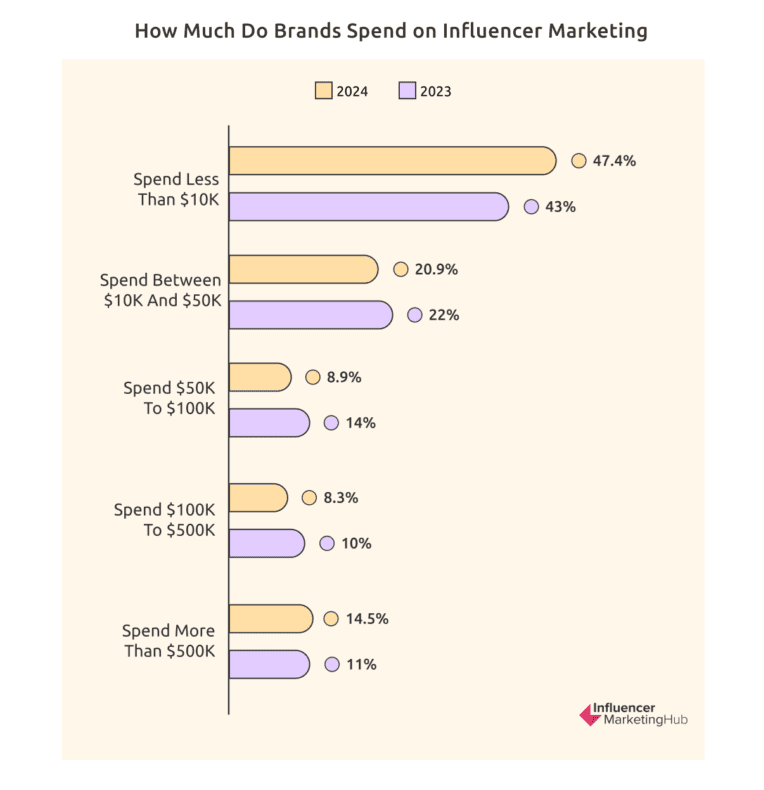
Source
Conclusion
Influencer marketing is a smart strategy that can greatly impact your business’s success. It focuses on using the genuine voices and influence of popular figures online rather than just chasing the latest trends.
Our influencer marketing stats show how powerful and effective it can be, and they can also help you figure out which platforms are best for reaching your target audience.
Remember, you don’t need a huge budget to team up with an influencer. The key is to create a campaign that connects with people and to choose the right influencer to work with.


